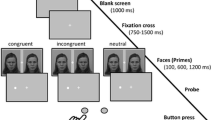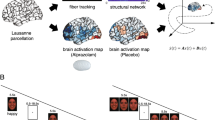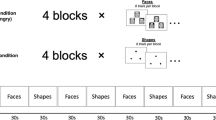Abstract
Rationale
Serotonergic (SSRI) and noradrenergic (NRI) antidepressants modulate biases in emotional processing such that perceptual bias is shifted away from negative and towards positive emotional material. However, the effects of serotonergic and noradrenergic modulation on the temporal course (occurring in milliseconds) of emotional processing, and in particular, the rapid physiological changes associated with the different stages of emotional processing, are unknown.
Objective
The current study assessed the effects of acute serotonergic (i.e. with citalopram) and noradrenergic (i.e. with reboxetine) augmentation on event-related potential (ERP) measures associated with ‘structural encoding’ (N170) and emotion expression decoding (N250 and late positive potential [LPP]) for positive (happy) and negative (sad) facial stimuli relative to neutral facial stimuli.
Materials and methods
This study employed a double-blind, placebo-controlled, cross-over design in which 12 healthy male participants completed a facial expression recognition task tested under three acute conditions: (a) placebo, (b) citalopram (20 mg) and (c) reboxetine (4 mg).
Results
Both citalopram and reboxetine had no effect on the N170 ERP component associated with structural encoding, but potentiated the N250 associated with happy (relative to neutral) emotional facial expression decoding. Both drugs had no valence effects on later ERP measures of emotion expression decoding (LPP).
Conclusions
Citalopram and reboxetine have selective effects on the temporal course of emotional processing with evidence to suggest specific effects on emotion expression decoding of positive (happy) emotional facial stimuli as evidenced by changes in the attention-modulated N250 but not structural encoding. These findings provide physiological evidence that antidepressants may shift perceptual biases in emotional processing away from negative and towards positive stimuli.




Similar content being viewed by others
References
Amaral DG, Behniea H, Kelly JL (2003) Topographic organisation of projections from the amygdala to the visual cortex in the macaque monkey. Neuroscience 118:1099–1120
Anderson IM, Del-Ben C, Mckie S, Richardson P, Williams SR, Elliott R, Deakin JF (2007) Citalopram modulation of neuronal responses to aversive face emotions: a functional MRI study. NeuroReport 18:1351–1355
Ashley V, Vuilleumier P, Swick D (2004) Time course and specificity of event-related potentials to emotional expressions. NeuroReport 15:211–216
Attenburrow MJ, Williams C, Odontiadis J, Reed A, Powell J, Cowen PJ, Harmer CJ (2003) Acute administration of nutritionally sourced tryptophan increases fear recognition. Psychopharmacology 169:104–107
Beck AT, Rush AJ, Shaw BF, Emery G (1979) Cognitive therapy of depression. Guildford, New York
Balconi M, Pozzoli U (2003) Face-selective processing and the effect of pleasant and unpleasant emotional expressions on ERP correlates. Int J Psychophysiol 49:67–74
Bentin S, Deouell L (2000) Structural encoding and identification in face processing: ERP evidence for separate mechanism. Cogn Neuropsychol 17:35–54
Bentin S, Allison T, Puce A, Perez E, McCarthy G (1996) Electrophysiological studies of face perception in humans. J Cogn Neurosci 8:551–565
Bond A, Lader M (1974) The use of analogue scales in rating subjective feelings. Br J Med Psychol 47:211–218
Bradley P, Mogg K, Millar N (1996) Implicit memory bias in clinical and non-clinical depression. Behav Res Ther 34:865–879
Breiter HC, Etcoff NL, Whalen PJ, Kennedy WA, Rauch SL, Buckner RL, Strauss MM, Hyman SE, Rosen BR (1996) Response and habituation of the human amygdala during visual processing of facial expression. Neuron 17:875–887
Bruce V, Young A (1986) Understanding face recognition. Br J Psychol 77:305–327
Calder AJ, Young AW (2005) Understanding the recognition of facial identity and facial expression. Nat Rev Neurosci 6:641–651
Carretie L, Iglesias J (1995) An ERP study on the specificity of facial expression processing. Int J Psychophysiol 19:183–192
Carlson PJ, Singh JB, Zarate CA, Drevets WC, Manji H (2006) Neural circuitry and neuroplasticity in mood disorders: insights for novel therapeutic targets. NeuroRx 3:22–41
Croft RJ, Barry RJ (2000) EOG correction of blinks with saccade coefficients: a test and revision of the aligned-artefact average solution. Clin Neurophysiol 111:444–451
D’Sa C, Duman R (2002) Antidepressants and neuroplasticity. Bipolar Disord 4:183–194
Del-Ben CM, William Deakin JF, Mckie S, Delvai NA, Williams SR, Elliot R, Dolan M, Anderson IM (2005) The effect of citalopram pre-treatment on neuronal responses to neuropsychological tasks in normal volunteers: an fMRI study. Neuropsychopharmacology 30:1724–1734
Dostert P, Benedetti MS, Poggesi I (1997) Review of the pharmacokinetics and metabolism of reboxetine, a selective noradrenaline reuptake inhibitor. Eur Neuropsychopharmacol 7(suppl 1):S23–S35
Dolan RJ, Fletcher P, Morris J, Kapur N, Deakin FW, Frith CD (1996) Neural activation during neural processing of positive emotional facial expressions. Neuroimage 4:194–200
Duman RS, Malberg J, Thome J (1999) Neural plasticity to stress and antidepressant treatment. Biol Psychiatry 46:1181–1191
Edwards DM, Pellizzoni C, Breud HP, Berardi A, Castelli MG (1995) Pharmacokinetics of reboxetine in healthy volunteers. Single oral dose, linearity and plasma protein binding. Biopharm Drug Dispos 16:443–460
Eimer M (2000) The face-specific N170 component reflects later stages in the structural encoding of faces. NeuroReport 11:2319–2324
Eimer M, Holmes A (2002) An ERP study on the time course of emotional face processing. NeuroReport 13:427–431
Eimer M, Holmes A (2006) Event-related potential correlates of emotional face processing. Neuropsychologia 45:15–31
Eimer M, Holmes A, McGlone FP (2003) The role of spatial attention in the processing of facial expression: an ERP study of rapid brain responses to six basic emotions. Cogn Affect Behav Neurosci 3:97–110
Ekman P, Friesen WV (1976) Pictures of facial affect. Consulting Psychologists, Palo Alto CA
Fitzgerald DA, Angstadt M, Jelsone LM, Nathan PJ, Phan KL (2006) Beyond threat: amygdala reactivity across multiple expressions of facial affect. NeuroImage 30:1441–1448
Fu CH, Williams SC, Cleare AJ, Brammer MJ, Walsh ND, Kim J, Andrew CM, Merlo Pich E, Williams PM, Reed LJ, Mitterschiffthaler MT, Suckling J, Bullmore ET (2004) Attenuation of the neural response to sad faces in major depression by antidepressant treatment: a prospective, event-related functional magnetic resonance imaging study. Arch Gen Psychiatry 61:877–889
Gessa GL, Biggio G, Fadda F, Corsini GV, Tagliamonte A (1974) Effect of the oral administration of tryptophan-free amino acid mixtures on serum tryptophan, brain tryptophan and serotonin metabolism. J Neurochem 22:869–870
Gur RC, Erwin RJ, Gur RE, Zwil AS, Heimberg C, Kraemer HC (1992) Facial emotion discrimination: 2. Behavioural findings in depression. Psychiatry Res 42:241–251
Hale WW (1998) Judgment of facial expressions and depression persistence. Psychiatry Res 80:265–274
Harmer CJ, Perrett DI, Cowen PJ, Goodwin GM (2001) Administration of the beta- adrenoceptor blocker propranolol impairs the processing of facial expressions of sadness. Psychopharmacology 154:383–389
Harmer CJ, Hill SA, Taylor MJ, Cowen PJ, Goodwin GM (2003a) Toward a neuropsychological theory of antidepressant drug action: increase in positive emotional bias after potentiation of norepinephrine activity. Am J Psychiatry 160:990–992
Harmer CJ, Bhagwagar Z, Perrett DI, Vollm BA, Cowen PJ, Goodwin GM (2003b) Acute SSRI administration affects the processing of social cues in healthy volunteers. Neuropsychopharmacology 28:148–152
Harmer CJ, Shelly NC, Cowen PJ, Goodwin GM (2004) Increased positive versus negative affective perception and memory in healthy volunteers following selective serotonin and norepinephrine reuptake inhibition. Am J Psychiatry 161:1256–1263
Harmer CJ, Mackay CE, Reid CB, Cowen PJ, Goodwin GM (2006) Antidepressant drug treatment modifies the neural processing of nonconscious threat cues. Biol Psychiatry 59:816–820
Hasselmo ME, Rolls ET, Baylis GC (1989) The role of expression and identity in the face-selective responses of neurons in the temporal visual cortex of the monkey. Behav Brain Res 32:203–218
Haxby JV, Ungerleider LG, Horwitz B, Ma.Maisog J, Rapoport SI, Grady CL (1996) Face encoding and recognition in the human brain. Proc Natl Acad Sci USA 93:922–927
Haxby JV, Hoffman EA, Gobbini M (2000) The distributed human neural system for face perception. Trends Cogn Sci 4:223–233
Herrmann MJ, Aranda D, Ellgring H, Mueller TJ, Strik WK, Heidrich A, Fallgatter AJ (2002) Face-specific event-related potential in humans is independent from facial expression. Int J Psychophysiol 45:241–244
Hoffmann EA, Haxby JV (2000) Distinct representations of eye gaze and identity in the distributed human neural system for face perception. Nat Neurosci 3:80–84
Holmes A, Winston JS, Eimer M (2005) The role of spatial frequency information for ERP components sensitive to faces and emotional facial expression. Cogn Brain Res 25:508–520
Hytell J (1994) Pharmacological characterization of selective serotonin re-uptake inhibitors (SSRIs). Int Clin Psychopharmacol 9(suppl 1):19–26
Invernizzi R, Belli S, Samanin R (1992) Citalopram’s ability to increase the extracellular concentrations of serotonin in the dorsal raphe prevents the drug’s effects in the frontal cortex. Brain Res 584:322–324
Invernizzi R, Velasco C, Bramante M, Longo A, Samanin R (1997) Effect of 5-HT1A receptor antagonists on citalopram-induced increase in extracellular serotonin in the frontal cortex, striatum and dorsal hippocampus. Neuropharmacology 36:467–473
Ivanoff J, Branning P, Marois R (2008) fMRI evidence for a dual process account of the speed–accuracy tradeoff in decision-making. PLoS ONE 3:e2635
Johnston VS, Wang XT (1991) The relationship between menstrual phase and the P300 component of the ERP. Psychophysiology 28:400–409
Johnston VS, Miller DR, Burleson MH (1986) Multiple P3s to emotional stimuli and their theoretical significance. Psychophysiology 23:684–693
Kastner S, Ungerleider LG (2000) Mechanisms of visual attention in the human cortex. Annu Rev Neurosci 23:315–341
Kayser J, Bruder GE, Tenke CE, Stewart JW, Quitkin FM (2000) Int J Psychophysiol 36:211–236
Kemp AH, Gray MA, Silberstein RB, Armstrong SM, Nathan PJ (2004a) Gender differences in the cortical electrophysiological processing of visual emotional stimuli. NeuroImage 21:632–646
Kemp AH, Gray MA, Silberstein RB, Armstrong SM, Nathan PJ (2004b) Augmentation of serotonin enhances pleasant and suppresses unpleasant cortical electrophysiological responses to visual emotional stimuli in humans. NeuroImage 22:1084–1096
Kerstenbaum R, Nelson CA (1992) Neural and behavioural correlates of emotion recognition in children and adults. J Exp Child Psych 54:1–18
Krolak-Salmon P, Fischer C, Vighetto A, Mauguiere F (2001) Processing of facial emotional expression: spatio-temporal data as assessed by scalp event-related potentials. Eur J Neurosci 13:987–994
Kornstein SG (1997) Gender differences in depression: implications for treatment. J Clin Psychiatry 58(supp 15):12–18
Labuschagne I, Croft RJ, Phan KL, Nathan PJ (2008) Augmenting serotonin neurotransmission with citalopram modulates emotional expression decoding but not structural encoding of moderate intensity sad facial emotional stimuli: an event related potential (ERP) investigation. J Psychopharmacology (in press)
Matthews GR, Antes JR (1992) Visual attention and depression: cognitive biases in the eye fixation of the dysphoric and non-depressed. Cogn Ther Res 16:359–371
McLeod C, Mathews A, Tata P (1986) Attentional bias in emotional disorders. J Abnorm Psychology 95:15–20
Munte TF, Brack M, Grootheer O, Wieringa BN, Matzke M, Johannes S (1998) Brain potentials reveal the timing of face identity and expression judgements. Neurosci Res 30:25–34
Murphy FC, Sahakian BJ, Rubinsztein JS, Michael A, Rogers RD, Robbins TW, Paykel ES (1999) Emotional bias and inhibitory control processes in mania and depression. Psychol Med 29:1307–1321
Murphy FC, Smith KA, Cowen PJ, Robbins TW, Sahakian BJ (2002) The effects of tryptophan depletion on cognitive and affective processing in healthy volunteers. Psychopharmacology 163:42–53
Murphy SE, Longhitano C, Ayers RE, Cowen PJ, Harmer CJ (2006) Tryptophan supplementation induces a positive bias in the processing of emotional material in healthy female volunteers. Psychopharmacology 187:121–130
Nathan PJ, Sitaram G, Stough C, Silberstein RB, Sali A (2000) Serotonin, noradrenaline and cognitive function: a preliminary investigation of the acute pharmacodynamic effects of a serotonin versus a serotonin and noradrenaline reuptake inhibitor. Behav Pharmacol 11:639–642
Nathan PJ, Segrave R, Phan KL, O’Neill B, Croft RJ (2006) Direct evidence that acutely enhancing serotonin with the selective serotonin reuptake inhibitor citalopram modulates the loudness dependence of the auditory evoked potential (LDAEP) marker of central serotonin function. Hum Psychopharmacol 21:47–52
Noble S, Benfiled P (1997) Citalopram: a review of its pharmacology, clinical efficacy and tolerability in the treatment of depression. CNS Drugs 8:410–431
Norbury R, Mackay CE, Cowen PJ, Goodwin GM, Harmer CJ (2007) Short-term antidepressant treatment and facial processing. Br J Psychiatry 190:531–532
Orozco S, Ehlers CL (1998) Gender differences in electrophysiological responses to facial stimuli. Biol Psychiatry 15:281–289
Page ME, Lucki I (2002) Effects of acute and chronic reboxetine treatment on stress-induced monoamine efflux in the rat frontal cortex. Neuropsychopharmacology 27:237–247
Perrett DI, Smith PA, Potter DD, Mistlin AJ, Head AS, Milner AD, Jeeves MA (1985) Visual cells in the temporal cortex sensitive to face view and gaze direction. Proc R Soc Lond B Biol Sci 223:293–317
Posamentier MT, Abdi H (2003) Processing faces and facial expressions. Neuropsychol Rev 13:113–143
Priskorn M, Larsen F, Segonzac A Moulin M (1997) Pharmacokinetic interaction study of citalopram and cimetidine in healthy subjects. Eur J Clin Pharmacol 52:241–242
Puce A, Allison T, McCarthy G (1999) Electrophysiological studies of human face perception. III: effects of top-down processing on face-specific potentials. Cereb Cortex 9:445–458
Puce A, Epling JA, Thompson JC, Carrick OK (2006) Neural responses elicited to face motion and vocalization pairings. Neuropsychologia 45:93–106
Roschmann R, Wittling W (1992) Topographic brain mapping of emotion-related hemisphere asymmetries. Int J Neurosci 63:5–16
Sacchetti G, Bernini M, Bianchetti A, Parini S, Invernizzi RW, Samanin R (1999) Studies on the acute and chronic effects of reboxetine on extracellular noradrenaline and other monoamines in the rat brain. Br J Pharmacol 128:1332–1338
Sato W, Kochiyama T, Yoshikawa S, Matsumara M (2001) Emotional processing boosts early visual processing of the face: ERP recording and its decomposition by independent analysis. NeuroReport 12:709–714
Schneider F, Habel U, Kessler C, Salloum JB, Posse S (2000) Gender differences in regions of cerebral activity during sadness. Hum Brain Mapp 9:226–238
Schupp HT, Cuthbert BN, Bradley MM, Cacioppo JT, Ito T, Lang PJ (2000) Affective picture processing: the late positive potential is modulated by motivational relevance. Psychophysiology 37:257–261
Schweinberger SR, Pickering EC, Jentzsch I, Burton AM, Kaufmann JM (2002) Event-related potential evidence for a response of inferior temporal cortex to familiar face repetitions. Cogn Brain Res 14:398–409
Schweinberger SR, Huddy V, Burton AM (2004) N250: a face selective brain response to stimulus repetitions. NeuroReport 15:1501–1505
Sheline YI, Barch DM, Donnelly JM, Ollinger JM, Snyder AZ, Mintum MA (2001) Increased amygdala response to masked emotional faces in depressed subjects resolves with antidepressant treatment: an fMRI study. Biol Psychiatry 50:651–658
Stein MB, Goldin PR, Sareen J, Zorrilla LTE, Brown GG (2002) Increased amygdala activation to angry and contemptuous faces in generalized social phobia. Arch Gen Psychiatry 59:1027–1034
Streit M, Wolwer W, Brinkmeyer J, Ihl R, Gaebel W (2000) Electrophysiological correlates of emotional and structural face processing in humans. Neurosci Lett 278:13–16
Sugase Y, Yamane S, Ueno S, Kawano K (1999) Global and fine information coded by single neurons in the temporal visual cortex. Nature 400:869–873
Surguldaze SA, Young AW, Senior C, Brebion G, Travis MJ, Phillips ML (2004) Recognition accuracy and response bias to happy and sad facial expressions in patients with major depression. Neuropsychology 18:212–218
Tabachnick BG, Fidell LS (2001) Using multivariate statistics, 4th edn. Allyn & Bacon, Boston MA
Thome J, Sakai N, Shin K, Steffen C, Zhang YJ, Impey S, Storm D, Duman RS (2000) cAMP response element-mediated gene transcription is upregulated by chronic antidepressant treatment. J Neurosci 20:4030–4036
van Veen V, Krug MK, Carter CS (2008) The neural and computational basis of controlled speed–accuracy tradeoff during task performance. J Cogn Neurosci 20:1–14
Vuilleumier P (2005) How brains beware: neural mechanisms of emotional attention. Trends Cogn Sci 9:585–594
Vulleumier P, Pourtois G (2006) Distributed and interactive brain mechanisms during emotion face perception: evidence from functional neuroimaging. Neuropsychologia 45:174–194
Weheid K, Alpay G, Jentzsch I, Sommer W (2005) Priming emotional facial expressions as evidenced by event-related brain potentials. Int J Psychophysiol 55:209–219
Williams LM, Plamer D, Liddell BJ, Song L, Gordon E (2006) The ‘when’ and ‘where’ of perceiving signals of threat versus non-threat. NeuroImage 31:458–467
Wojciulik E, Kanwisher N, Driver J (1998) Covert visual attention modulates face-specific activity in human fusiform gyrus: fMRI study. J Neurophysiol 79:1574–1578
Wong E, Sonders MS, Amara SG, Tinholt PM, Piercey M, Hoffmann WP, Hyslop DK, Franklin S, Porsolt RD, Bonsignori A, Carfagna N, McArthur RA (2000) Reboxetine: a pharmacologically potent, selective and specific norepinephrine reuptake inhibitor. Biol Psychiatry 47:818–829
Young SN, Smith SE, Phil RO, Ervin FR (1985) Tryptophan depletion causes a rapid lowering of mood in normal males. Psychopharmacology 87:173–177
Young AW, Rowland D, Calder AJ, Etcoff NL, Seth A, Perrett DI (1997) Facial expression megamix: tests of dimensional and category accounts of emotion recognition. Cognition 63:271–313
Zhai S, Kong J, Ren X (2004) Speed–accuracy trade-off in Fitts’ law tasks on the equivalency of actual and nominal precision. Int J Human–Comput Stud 61:823–856
Acknowledgement
Fellowship support for PJN was provided by the National Health and Medical Research Council (NHMRC) of Australia.
Author information
Authors and Affiliations
Corresponding authors
Rights and permissions
About this article
Cite this article
Kerestes, R., Labuschagne, I., Croft, R.J. et al. Evidence for modulation of facial emotional processing bias during emotional expression decoding by serotonergic and noradrenergic antidepressants: an event-related potential (ERP) study. Psychopharmacology 202, 621–634 (2009). https://doi.org/10.1007/s00213-008-1340-3
Received:
Accepted:
Published:
Issue Date:
DOI: https://doi.org/10.1007/s00213-008-1340-3




